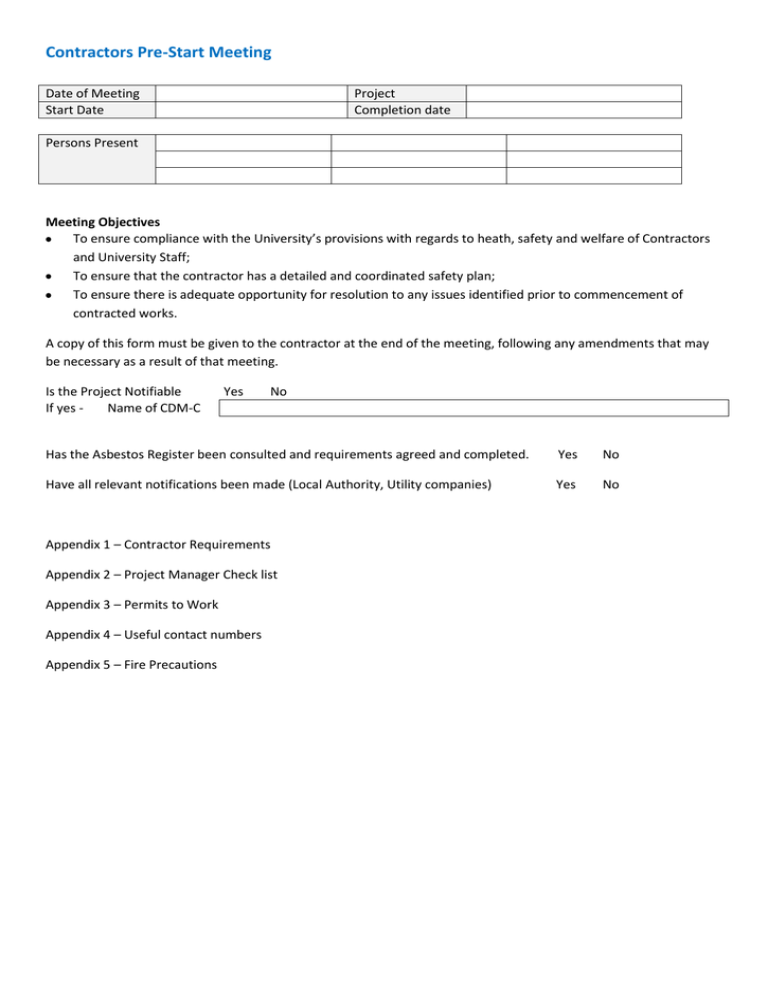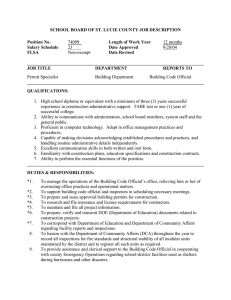Contractors Pre-Start Meeting
advertisement

Contractors Pre-Start Meeting Date of Meeting Start Date Project Completion date Persons Present Meeting Objectives To ensure compliance with the University’s provisions with regards to heath, safety and welfare of Contractors and University Staff; To ensure that the contractor has a detailed and coordinated safety plan; To ensure there is adequate opportunity for resolution to any issues identified prior to commencement of contracted works. A copy of this form must be given to the contractor at the end of the meeting, following any amendments that may be necessary as a result of that meeting. Is the Project Notifiable If yes Name of CDM-C Yes No Has the Asbestos Register been consulted and requirements agreed and completed. Yes No Have all relevant notifications been made (Local Authority, Utility companies) Yes No Appendix 1 – Contractor Requirements Appendix 2 – Project Manager Check list Appendix 3 – Permits to Work Appendix 4 – Useful contact numbers Appendix 5 – Fire Precautions Contractors Pre-Start Meeting Appendix 1 - Requirements of Contractor The following should already have been provided to the Project Manager prior to contract being awarded Safety Policy and arrangements Risk assessments, methods statements and/or safe systems of work supplied Please ensure the following are also provided Name of site responsible supervisor for safety. Emergency contact details for all attending site In the event of an incident on site Must notify Project Manager / Contracts Administrator immediately of any accidents or incidents, and all major injuries, including 7 day injuries and dangerous occurrences must be notified to the HSE. A copy of the RIDOOR report must be supplied to the University. Other requirements Electrical supply for tools and equipment must not be in excess of 110 volts All equipment brought to site must be fit for purpose and where necessary, inspected and tested in accordance with relevant legislation. Ensure the Project Manager / Contracts Administrator is made aware of any changes that may be required / requested before the changes take place. Ensure all who are likely to work on site (inc. sub-contractors) have received the University Health and Safety Induction for contractors. Contractors Pre-Start Meeting Appendix 2 – Project Manager Check list Yes Risk Assessments and Method statements provided and reviewed to be acceptable Asbestos reviews and relevant surveys completed and information provided to the contractor and the CDM-C Is chemical use planned and substances agreed in accordance with University requirements Ensure competencies are relevant for the of work being undertaken by the contractor eg Gas Safe engineers; NICEIC electricians etc. Permit Arrangements discussed with contractor Fire Precautions discussed and agreed with contractor – see appendix 5 Welfare facilities and first aid arrangements agreed with contractor PPE arrangements reviewed and agreed for contractors and visitors to site Will lighting levels be adequate If no – what are the proposed resolutions: Will any lifting operations require the use of cranes If Yes, Consider competence of operatives, banksman, control of lifting area Scaffold required If yes, handover certificates or tag required, must be completed by competent person and in date Protection from fall – edge protection for roof (permit required), excavations (permit needed) and voids. No N/A Contractors Pre-Start Meeting Appendix 3 - Permit To Work The following types of work will require a permit to be issued Any work which involves digging / breaking into the ground of the University - Ground excavations Entry into a Confined Space All temporary operations involving open flames or producing heat and/or sparks, this includes, but is not limited to, Brazing, Cutting, Grinding, Soldering, Thawing, and Welding require a Hot Work permit. Access for maintenance / repair to Laboratories, Workshops and Plant rooms Access to a Roof or activities involving working at height Isolation of services other than electrical isolation Work in Electrical substations - for these please contact Neil Williams Work on a sink within a laboratory Issue and close out of permits Permits are issued by the Contract Administrator or Project Manager within the Estates Department. Permits must be closed out by the issuing manager within the timescale indicated on the permit. Notification period Notice is required for the issuing of a permit. This gives the issuing Contract Administrator or Project Manager time to assess the documentation and agree other actions as required. The majority of work is pre-planned so this notification period will not impact on the job if it is managed appropriately. However, there are situations, unplanned events, where this notification period cannot be met. These will be dealt with on an individual basis. When is a permit NOT required? Where the work is on simple systems with dedicated local isolation, and present minimal risk, or has no secondary impact on other users. However, a risk assessment and method statements should still be provided to the Contract Administrator or Project Manager and any necessary control measures put in place before works commence. Contractors Pre-Start Meeting Appendix 4 – Useful Contact Numbers Health and Safety at Warwick You must be ‘Competent’ to carry out the work for which you have been engaged Always report to your allotted point of contact before work commences and report before leaving site Familiarise yourself with your work surroundings Know the location of the nearest fire exits and assembly points. Find out on what day the fire alarm sounders are tested where you are working, you do not need to leave the building at this time unless the alarm sounds for more than 30 seconds Keep your work area tidy, consider others working in that area and keep them informed where necessary Ensure you use your appropriate PPE and follow relevant procedures Report any accidents to your manager and ensure the University representative has been made aware First aiders are available - contact security should you require help If you require any chemicals to carry out your work, ensure they have been approved by the University representative Certain activities require a permit before work can commence. Ensure a permit is in place before you commence these activities (e.g. Roof work, hot work, confined space) Full details of contractor responsibilities can be found in the Contractor Safety document issued pre-start meeting If in any doubt about your work, ASK for help Useful Contact Numbers University Project Manager Security 22083 (024 7652 2083) Emergency Contact whilst onsite at 024765 22222 the University No contact to be made direct with emergency services. Health and Safety Executive 0845 345 0055 Coventry County Council 0247 683 3333 Warwick District Council 01926 410410 Appendix 5 – Fire Precautions The instruction and check sheet in this Appendix will give you the ability to make a basic assessment of the work you are planning to determine if you require additional support from the University’s Fire Safety adviser. The instructions set out below are mandatory aspects, which as the project manager or as the individual commissioning work you should be putting in place and communicating to people in the building where your planned work is being carried out and to those carrying out the work: Are measures in place to ensure staff and other building occupants are informed of the temporary effects and the actions required in the event of a fire incident during the planned work? Ensure the contractor provides first-aid fire fighting measures for the work area which are appropriate If the work is likely to create dust or fumes then arrangements must be made for the smoke detection system to be either isolated or detector heads capped. Activities such as sweeping up, drilling, sanding demolition, and hot work can all create dust/fume levels capable of triggering automatic fire detection. Any temporary alterations to the fire detection and alarm system including covering detectors must be agreed with the Low Voltage Systems & Network Engineer and the Project Sponsor. These should be pre-planned prior to starting work on site. Ensure any hot works that use or create a flame, heat or sparks, that could give rise to risk of fire and ignition of flammable substances and combustible materials – must be controlled via a Hot Works Permit. By completing the check list below it will identify if the planned work requires input from the University’s Fire Safety Adviser to ensure an adequate level of fire safety is achieved. If the answer is ‘Yes’ to any of the questions below, then notify the Fire Safety Adviser who will advise on the adequacy of the work proposed and on any further precautions required. Consider the following in relation to the planned work… 1. General 2. Alarm and detection 3. Escape routes 4. Emergency lighting 5. First aid fighting equipment 6. Compartmentation 7. Construction materials A. Will the work result in a change in the occupancy profile e.g. from office use to sleeping accommodation? A. Will the planned work require the location of existing smoke detectors and/or fire alarm sounders to be re-located? B. Will the planned work result in the creation of a new room (Either by forming a new room as a standalone structure or by subdividing an existing space)? A. Will the planned work result in permanent removal or relocation of existing emergency exits (including removal of doors or staircases)? B. Will the planned work result in alteration to the existing door release mechanisms on any doors on an escape route or the final exit door from the building? C. Will new security measures be added to any doors on an escape route? D. Will the planned work result in an existing escape route being changed that might affect emergency exit signage? E. Will the planned work deliver facilities specifically for disabled persons where there was previously none i.e. installation of a lift? A. Will the planned work result in the creation of a new room with a floor area in excess of 8m2(Either by forming a new room or a subdividing an existing space)? A. Will the planned work require existing first aid firefighting equipment to be relocated? A. Will the planned work breach any existing compartment walls or affect any protection to openings in them e.g. fire doors. A. Do the proposed construction materials constitute an obvious fire hazard e.g. polystyrene insulation and/or exposed timber sheet linings (not timber stud work), Yes/ No/ N/A 8. Construction waste A. Where a skip and combustible building materials are to be stored externally, and materials has an area 10m away from the building been allocated for their storage?



